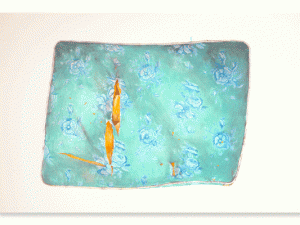Painting Now at Tate Britain celebrates a selection of five contemporary painters, each displaying a synopsis of their unique stylistic vision. The artists that were on display were: Tomma Abts, Gillian Carnegie, Simon Ling, Lucy McKenzie and Catherine Story. Areas of the gallery were confined according to artist, and the works intertwine between abstraction, realism, fauvism and any number of painterly tools from the reaches of art history. Painting Now does not present a survey of the state of painting today where the artists involved are the next generation in a new sweeping movement of painters. What it did offer, was a fleeting glimpse at the ever-evolving boundaries of painting being questioned.
It would seem that the ever prominent traditions of medium are being eroded away to be replaced by an umbrella of neo-conceptual thought that gives an eternal freedom of metamorphosis within art. Michael Craig-Martin’s Oak Tree (1973) being the definitive example, where he labelled a glass of water an oak tree. Similarly here at the Tate this metamorphosis is present, none more so than in Lucy McKenzie’s work, which utilizes paint as a tool – a means to an end to create a symposium addressing domestic architecture. Loos House (2013) is a replica of marble decoration from the living room of Villa Müller designed by Austrian architect Adolf Loo. Like Michael Craig-Martin’s Oak Tree, Lucy McKenzie’s work directs the painted wood to superficially act as something else, giving the work a paralleling subversive discourse with perception and function of materiality.
Despite Tomma Abt’s insistence that her work is neither figurative nor abstract (aesthetically speaking), both Tomma Abts’ and Catherine Story’s works employ varying stances of painterly abstraction. Tomma Abts’ Zebe (2010) depicts diagonal lines in garish oranges and soft greys, which dissect each other, broken by sweeping curved stripes that lie on top. The painting culminates in a series of regulations guided by intrinsic logic learnt from the first mark produced. Catherine Story’s Lowland (I) (2012) operates under different perceptions. A muted pastel colour pallet of blues and browns is synthesized with reductionism, depicting a dog from behind waiting for its master, head cocked to the right… or so it would appear. But like Tomma Abts’ guide of intrinsic logic, one is forced to extract meaning or representation from Catherine Story’s Lowland (I).
Reductionism is a theme that extends throughout Simon Ling’s work. Harsh freehand-expressive depictions of urban landscapes long forgotten and left to the sands of time crumble and decay before the viewer’s eyes. In Untitled (2012), bare discoloured grey brick work frames a battered window sachet; the blackened void of the window glares ominously over a dilapidated shop front with fauvist streaks of youthful vitality. But when this use of colour is compared to that of the works of Gillian Carnegie’s, a fascinating duck-rabbit between realism and painterly aesthetic is revealed.
Gillian Carnegie’s Prince (2010) uses – as do the majority of her paintings on display – a serenely solemn pallet of grey-green and seductive blacks (reminiscent of Hammershøi) depicting a black cat on a staircase. The black cat seeps into the shadows on the staircase, and the greens and straight lines of the detailing promote the sensual curves of the cat. The wall behind the cat is streaked with orchestrated brush marks that allude to general domestic ware in such a that one is made aware of this being a painting through the sheer prominence of the brush marks, yet simultaneously these combine to create an inescapable vision of their. These works, it would appear, illustrate that Painting Now, as an exhibition, does not invite an audience to gaze into the future of where painting will be, rather, it subjects one to the process of challenging the notion of what painting is.
Painting Now: Five Contemporary Artists, 12 November – 9 February, Tate Britain.
William Davie
Credits
1. Tomma Abts, Jeels 2012, Collection of Sasha S Bauer © Tomma Abts, Courtesy Galerie Buchholz, Berlin/Cologne Photo: Courtesy Galerie Buchholz, Berlin / Cologne.





